

Deep and Surface learning. It is important to clarify what they are not.
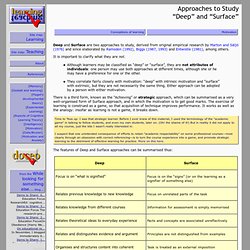
Although learners may be classified as “deep” or “surface”, they are not attributes of individuals: one person may use both approaches at different times, although she or he may have a preference for one or the other. They correlate fairly closely with motivation: “deep” with intrinsic motivation and “surface” with extrinsic, but they are not necessarily the same thing. Either approach can be adopted by a person with either motivation.
There is a third form, known as the “Achieving” or strategic approach, which can be summarised as a very well-organised form of Surface approach, and in which the motivation is to get good marks. The exercise of learning is construed as a game, so that acquisition of technique improves performance. Time to 'fess up: I was that strategic learner. Mentis et al chapter 2012. Evidence Based Practice Resource List (1) Communities of Practice Wenger. Education Research Highlights From 2016. In 2016, we learned more about how teachers feel about their profession, from the reasons why they started teaching in the first place (#1) to why they leave (#6). We learned that science students do better when teachers share stories about the struggles scientists face instead of portraying them as geniuses (#3).
We’re also learning more about why U.S. students are falling behind students in other countries (#12). Here are 15 studies published this year that every educator should know about. 1. It Turns Out Teaching Really Is a Noble Profession Altruism drives many people to become teachers, according to this survey of over 3,000 public school teachers. Rentner, D.S., Kober, N., & Frizzell, M. (2016). 2. Are kindergartners spending too much time on academics? Bassok, D., Latham, S., & Rorem, A. (2016). 3. It turns out that the idea of genius might intimidate young learners. Lin-Siegler, X., Ahn, J. 4. Cherng, H. 5. Stanford History Education Group. (2016). Greenberg, M. 7. Yeager, D. The Tyranny of Being On Task. I remember when I was first teaching and was getting ready for my first official observation and evaluation.

I was very nervous. My principal had told me she would be looking for a classroom where students were on task. Heaven forbid that any students were off task. I thought that if my classroom even hinted that some students were off task, I would never be a successful teacher, and perhaps told to leave the teaching profession. 12 Principles Of Modern Learning. 12 Principles Of Modern Learning by TeachThought Staff What are the principles of modern learning?
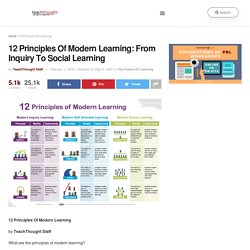
Well, that depends on how you define ‘learning’ and what you’d consider ‘modern.’ Richard Olsen put together this useful visual way, way back in 2013–a chart that lays out three categories of a modern approach to learning–Modern, Self-Directed, and Social. These broad categories are then broken up into four principles per category.
8 Myths That Undermine Educational Effectiveness. Certain widely-shared myths and lies about education are destructive for all of us as educators, and destructive for our educational institutions.
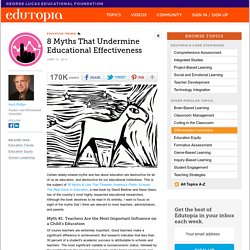
This is the subject of 50 Myths & Lies That Threaten America’s Public Schools: The Real Crisis in Education, a new book by David Berliner and Gene Glass, two of the country’s most highly respected educational researchers. Although the book deserves to be read in its entirety, I want to focus on eight of the myths that I think are relevant to most teachers, administrators, and parents. Myth #1: Teachers Are the Most Important Influence on a Child’s Education Of course teachers are extremely important. Good teachers make a significant difference in achievement. Myth #2: Homework Boosts Achievement There is no evidence that this is true. Myth #3: Class Size Does Not Matter In an average high school, one teacher is responsible for 100-150 students on any given day. Myth #4: A Successful Program Works Everywhere. Teenagers can become disruptive if teachers use psychological pressure - UKEdChat.com.
Interprofessional Education/Interprofessional Practice (IPE/IPP) ASHA adapted the World Health Organization [PDF] definitions of interprofessional education (IPE) and interprofessional practice (IPP), also called interprofessional collaborative practice, to reflect audiologists' and speech-language pathologists' (SLPs') engagement in IPP in both health care and education settings.
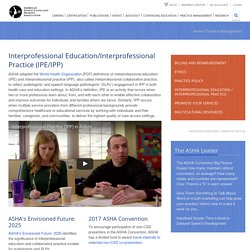
In ASHA's definition, IPE is an activity that occurs when two or more professions learn about, from, and with each other to enable effective collaboration and improve outcomes for individuals and families whom we serve. Similarly, IPP occurs when multiple service providers from different professional backgrounds provide comprehensive healthcare or educational services by working with individuals and their families, caregivers, and communities- to deliver the highest quality of care across settings. Framework for action on interprofessional education and collaborative practice. Mindfulness ECE Darcy. Evidencebasedteaching.org.au What Everyone Needs to Know About High Performance Teacher Student Relationships. Creating Mentorship Metaphors Pacific Island Perspectives.
Child voice in research silence. AbilityGroupinNZHighSchools. K-12 Education Tips & Strategies That Work. Inclusive Practices Toolkit. Interprofessional Education and Collaborative Practice Resources. Interprofessional education and collaborative practice resources provide information on various topics related to interprofessional education resources and that may inform curriculum development and clinical education, as well as offer other opportunities available to physical therapy educators in this arena.
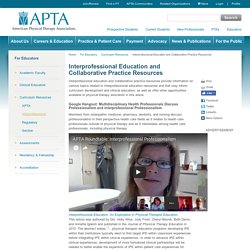
Google Hangout: Multidisciplinary Health Professionals Discuss Professionalism and Interprofessional Professionalism Members from osteopathic medicine, pharmacy, dentistry, and nursing discuss professionalism in their perspective health care fields as it relates to health care professionals outside of physical therapy and as it interrelates among health care professionals, including physical therapy Interprofessional Education: An Exploration in Physical Therapist EducationThis article was authored by Drs.